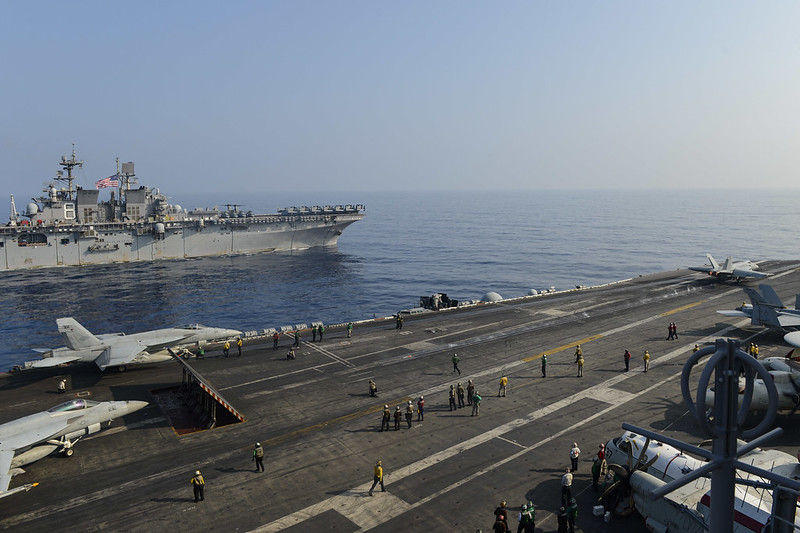Neither Canada nor Australia currently has a comprehensive strategy for the Indo-Pacific region. But it’s essential that both develop one given the rapidly evolving environment in the area.
First, NATO recognized the importance of the region at its June 2022 summit in Madrid, and second, it named the People’s Republic of China as a challenge to the alliance’s interests, security and values.
Canada is a NATO member, and Australia is an “enhanced opportunities partner” along with Japan, Korea and New Zealand. How middle-power countries like Canada and Australia respond to these challenges and contribute to NATO’s new “Strategic Concept” — the alliance’s plan to deal with ongoing risks — will be vital.
Both countries have relied to date on news releases, ministerial statements and readouts to convey their approach to the Indo-Pacific. Now they must map out more authoritative and detailed Indo-Pacific strategies.
Military muscle flexing
Indo-Pacific nations have been watching with concern as North Korea dramatically increased its missile testing. Chinese aggression has also intensified in the South China and East China Seas, including over-fishing and military muscle-flexing.
In late May, in separate locations, Chinese fighters aggressively intercepted Australian and Canadian maritime patrol aircraft in the western Pacific.
China has also made its intentions in the South Pacific clear by announcing a supposed security agreement with the Solomon Islands and attempting to co-ordinate a new region-wide security arrangement, including policing and cybersecurity.
Although the security arrangement wasn’t accepted by the Pacific Islands Forum, the Chinese Foreign Ministry has declared its determination to continue to pursue these goals. The U.S. is becoming more engaged as a response.
Australia’s Foreign Minister Penny Wong recently referred to “strategic equilibrium” when calling on China to show restraint in its dealings with smaller countries, and to use its influence over Russia to end the war in Ukraine.
At the same time, countries that have experienced Beijing’s trade coercion and hostage diplomacy are now seeking to deepen relations with countries other than China in the Indo-Pacific region.
Australian, Canadian policy
Against this backdrop, it’s surprising that neither Canada nor Australia has a comprehensive, coherent and up-to-date Indo-Pacific strategy.
Australia’s approach is based on an amalgam of policies, including a 2017 foreign policy white paper that has a section referring to the Indo-Pacific, a 2020 Defence Department update and various ministerial announcements and news releases.
Policy examples include the Quadrilateral Security Dialogue also involving the U.S., Japan and India (known as the Quad), the controversial AUKUS agreement, Australia’s membership in the Pacific Islands Forum and Prime Minister Anthony Albanese’s statement at the Madrid NATO Summit.
Canada has also relied on ministerial statements, readouts and news releases to demonstrate its commitment to the Indo-Pacific. However, since November 2019, Justin Trudeau’s government has been developing an Indo-Pacific strategy involving consultations with several countries in the region and engagement across federal government departments to ensure an “all-of-government approach.”
Similarly, in December 2019, Canada announced it would also develop “a new framework for Canada-China relations.”
No substance from Canada
But a year later, François-Philippe Champagne, the foreign affairs minister at the time, said there would be no document, describing the framework as comprising a “challenge, coexist, compete” approach.
In Parliament, he said the following:
- “The China of 2020 is not the China of 2016” when there were still hopes for a Canada-China free-trade agreement.
- “National security will be the prime criterion for the Huawei decision.” The government later banned the Chinese tech giant from Canada’s 5G network.
- “The Michaels are not just Canadian citizens, they’re citizens of a liberal democracy.”
The final point was meant to argue that all liberal democracies had a stake in the plight of Canadians Michael Korvig and Michael Spavor, known as the “two Michaels,” who returned to Canada in 2021 after spending more than 1,000 days detained in China.
But in our view, as scholars of policy and legal frameworks, taglines do not make a China framework.
If Canada continues to express its Indo-Pacific strategy via ministerial statements — as has been discussed within government, according to an internal source of ours — it would fall far short of what Canadians and Indo-Pacific nations need and deserve.
Speeches, statements and readouts cannot by themselves reflect a coherent, comprehensive strategy. Far more detail is required to demonstrate Canada’s role, including substantive operational and financial commitments.
Lack of urgency
Given the fate of Canada’s China framework and the apparent lack of urgency in developing a Canadian national security strategy, it’s concerning that there’s apparently still no comprehensive strategy for the Indo-Pacific.
An Indo-Pacific Advisory Committee was appointed in June 2022, further delaying the process. This risks disappointing partners in the region who have expected a strategy for years and could result in lost opportunities, including collaborations on trade, security, technology, population health, research and development, sustainable fisheries management, tourism and higher education.
It’s in Canada’s interests to play a substantive role as a regional partner, not just an occasional visitor.
Similarly, Australia’s newly elected Albanese has identified key themes, including creating a “strategic equilibrium,” recognizing that countries will make their own sovereign choices, working with trusted friends and partners, being resolute in defending democracy and upholding core values of fairness.
These are good starting points for a framework. The Albanese government is seeking to take a fresh approach to the region, but it will need to expand these broad political ideals beyond news releases and rhetorical flourishes.
As with Canada, the challenge is to develop comprehensive, integrated Indo-Pacific strategies addressing the real risks to regional peace and security.
Substantive strategies needed
While Canada and Australia strive at diplomatic levels to reset their China relationships, their Indo-Pacific strategies must, at the same time, explicitly recognize the significant risks China is posing.
Using co-ordinated middle-power strategies to stabilize relations and to encourage China to demonstrate restraint in exercising its power, especially with smaller countries in the region, is a useful first step.
But comprehensive strategies are now imperative to navigate the growing challenges across the Indo-Pacific.
When Trudeau and Albanese spoke in May, they “agreed to advance common objectives in the Indo-Pacific region, especially in working with partners and allies to promote security and uphold democratic values … and to work together to advance shared priorities.”
To support these shared principles, substantive strategies will be essential.



 Argentina Unions Rally Against Milei’s Labor Reform as Congress Debates Key Bill
Argentina Unions Rally Against Milei’s Labor Reform as Congress Debates Key Bill  Trump Administration Proposes Sweeping Limits on Gender-Affirming Care for Children
Trump Administration Proposes Sweeping Limits on Gender-Affirming Care for Children  Trump Attends Dover Ceremony Honoring U.S. Personnel Killed in Syria
Trump Attends Dover Ceremony Honoring U.S. Personnel Killed in Syria  Federal Appeals Court Allows Trump’s National Guard Deployment in Washington, D.C. to Continue
Federal Appeals Court Allows Trump’s National Guard Deployment in Washington, D.C. to Continue  Trump Announces $1,776 Cash Bonus for U.S. Military Personnel Ahead of Christmas
Trump Announces $1,776 Cash Bonus for U.S. Military Personnel Ahead of Christmas  Union-Aligned Investors Question Amazon, Walmart and Alphabet on Trump Immigration Policies
Union-Aligned Investors Question Amazon, Walmart and Alphabet on Trump Immigration Policies  Barham Salih Elected as Next UN High Commissioner for Refugees
Barham Salih Elected as Next UN High Commissioner for Refugees  U.S. House Advances GOP Healthcare Bill as ACA Subsidies Near Expiration
U.S. House Advances GOP Healthcare Bill as ACA Subsidies Near Expiration  Pakistan’s Army Chief Faces Gaza Troop Dilemma Amid US Pressure
Pakistan’s Army Chief Faces Gaza Troop Dilemma Amid US Pressure  Honduras Election Recount Delayed Amid Protests and Political Tensions
Honduras Election Recount Delayed Amid Protests and Political Tensions  Italy Supreme Court Upholds Salvini Acquittal in Migrant Kidnapping Case
Italy Supreme Court Upholds Salvini Acquittal in Migrant Kidnapping Case  Canada Signals Delay in US Tariff Deal as Talks Shift to USMCA Review
Canada Signals Delay in US Tariff Deal as Talks Shift to USMCA Review  Zelenskiy Urges Allies to Use Frozen Russian Assets as EU Summit Nears
Zelenskiy Urges Allies to Use Frozen Russian Assets as EU Summit Nears  U.S. Initiates $11.1 Billion Arms Sale to Taiwan Amid Rising China Tensions
U.S. Initiates $11.1 Billion Arms Sale to Taiwan Amid Rising China Tensions  Dan Bongino to Step Down as FBI Deputy Director After Brief, Controversial Tenure
Dan Bongino to Step Down as FBI Deputy Director After Brief, Controversial Tenure  Trump Administration Plans Major Increase in Denaturalization Cases for Naturalized U.S. Citizens
Trump Administration Plans Major Increase in Denaturalization Cases for Naturalized U.S. Citizens 




























